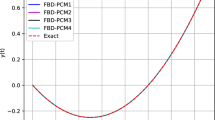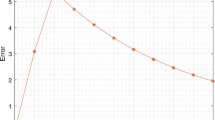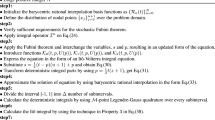Abstract
In this paper, first, we propose an iterative method based on quadrature formula for solving two-dimensional linear fuzzy Fredholm integral equations (2DLFFIE). Then, we prove the error estimation of the method. In addition, we show the numerical stability analysis of the method with respect to the choice of the first iteration. Finally, supporting examples are also provided.
Similar content being viewed by others
Introduction
The study of fuzzy differential and integral equations begins with the research of Kaleva [13] and Seikkala [21]. As we know, showing the existence and uniqueness solution of these equations is very important. So, to this end, many authors applied the Banach’s fixed point theorem and the method of successive approximations. Recently, many researchers proposed numerical methods for solving fuzzy Fredholm integral equations (FFIEs). To see more details about solving FFIE, one can refer to [2, 4–6, 8–12, 15, 16, 18, 19, 22, 23].
Solving linear and nonlinear FFIEs based on iterative method is done by many authors but for the first time, solving 2DLFFIEs was studied by authors of [18] that the authors proved the existence and uniqueness solution of these equations by using Banach’s fixed point theorem. In addition, in [19], authors presented a numerical method for solving two-dimensional nonlinear FFIEs by using an iterative method. Recently, authors of [7, 14, 17, 20] proposed some numerical approaches to solve 2DLFFIEs.
Here, we propose a numerical method for solving (3.1). In addition, we present the estimation error and the numerical stability analysis. The rest of the paper is organized as follows: In “Preliminaries”, we review some properties for fuzzy-number-valued functions, such as continuity, boundedness, fuzzy Henstock and fuzzy Riemann integrability and fuzzy quadrature rules . In “2D linear fuzzy Fredholm integral equations”, we propose a new approach based on quadrature rule and iterative method to solve 2DLFFIEs. In “Convergence analysis”, we investigate convergence analysis of the proposed method. Considering the numerical stability analysis of the proposed method is done in “Numerical stability analysis”. Finally, some numerical examples are presented in “Numerical examples”.
Preliminaries
At first, we present some basic definitions and necessary results about fuzzy set theory.
Definition 2.1
[1] A fuzzy number is a function \(u:\mathbb {R}\rightarrow [0,1]\) with the following properties:
-
1.
u is normal, i.e. \(\exists x_{0}\in \mathbb {R}\); \(u(x_{0})=1\).
-
2.
\(u(\eta x+(1-\eta )y)\ge \min \{u(x),u(y)\}\forall x,y\in \mathbb {R},\forall \eta \in [0,1]\) (u is called a convex fuzzy subset).
-
3.
u is upper semicontinuous on \(\mathbb {R}\), i.e., \(\forall x_{0}\in \mathbb {R}\) and \(\forall \epsilon >0\), \(\exists\) neighborhood \(V(x_{0}):u(x)\le u(x_{0})+\epsilon , \forall x\in V(x_{0})\).
-
4.
The set \(\overline{supp(u)}\) is compact in \(\mathbb {R}\) (where \(supp(u):=\{x\in \mathbb {R}; u(x)>0\}\)).
The set of all fuzzy numbers is denoted by \(\mathbb {R}_{F}\).
Definition 2.2
[1] For \(0<r\le 1\) and \(u\in \mathbb {R}_{F}\) define \([u]^{r}:=\{x\in \mathbb {R}: u(x)\ge r\}\) and
It is well known that for each \(r\in [0,1]\), \([u]^{r}\) is a closed and bounded interval of \(\mathbb {R}\). For \(\tilde{u}\), \(\tilde{v}\in \mathbb {R}_{F}\) and \(\lambda \in \mathbb {R}\), we define uniquely the sum \(\tilde{u}\oplus \tilde{v}\) and the product \(\lambda \odot \tilde{u}\) by
where \([\tilde{u}]^{r}+[\tilde{v}]^{r}\) means the usual addition of two intervals (as subsets of \(\mathbb {R}\)). Also, \(\lambda [\tilde{u}]^{r}\) means the usual product between a scalar and a subset of \(\mathbb {R}\). Notice \(1\odot \tilde{u}=\tilde{u}\) and it holds \(\tilde{u}\oplus \tilde{v}=\tilde{v}\oplus \tilde{u}\), \(\lambda \odot \tilde{u}=\tilde{u}\odot \lambda\). If \(0\le r_{1}\le r_{2}\le 1\) then \([\tilde{u}]^{r_{2}}\subseteq [\tilde{u}]^{r_{1}}\). Actually \([\tilde{u}]^{r}=[\tilde{u}_{-}^{(r)},\tilde{u}_{+}^{(r)}]\), where \(\tilde{u}_{-}^{(r)}\le \tilde{u}_{+}^{(r)}\), \(\tilde{u}_{-}^{(r)}\), \(\tilde{u}_{+}^{(r)}\in \mathbb {R}\), \(\forall r\in [0,1]\). For \(\lambda >0\) one has \(\lambda \tilde{u}_{\pm }^{(r)}=(\lambda \odot \tilde{u})_{\pm }^{(r)}\), respectively.
Definition 2.3
[1] Define \(D:\mathbb {R}_{F}\times \mathbb {R}_{F}\rightarrow \mathbb {R}_{+}\) by
where \([\tilde{v}]^{r}=[\tilde{v}_{-}^{(r)},\tilde{v}_{+}^{(r)}]\); \(\tilde{u}\), \(\tilde{v}\in \mathbb {R}_{F}\). Clearly, D is a metric on \(\mathbb {R}_{F}\). Also \((\mathbb {R}_{F},D)\) is a complete metric space, with the following properties [1]:
Definition 2.4
[1] Let \(f,g:\mathbb {R}\rightarrow \mathbb {R}_{F}\) be fuzzy number valued functions. The distance between f, g is defined by
Lemma 2.5
[1]
-
1.
If we denote \(\tilde{0}:=\chi _{\{0\}}\) , then \(\tilde{0}\in \mathbb {R}_{F}\) is the neutral element with respect to \(\oplus\) , i.e., \(\tilde{u}\oplus \tilde{0}=\tilde{0}\oplus \tilde{u}=\tilde{u}\), \(\forall \tilde{u}\in \mathbb {R}_{F}\).
-
2.
With respect to \(\tilde{0}\) , none of \(\tilde{u}\in \mathbb {R}_{F}\), \(\tilde{u}\ne \tilde{0}\) has opposite in \(\mathbb {R}_{F}\).
-
3.
Let \(\alpha\), \(\beta \in \mathbb {R}: \alpha .\beta \ge 0\) , and any \(\tilde{u}\in \mathbb {R}_{F}\) , we have \((\alpha +\beta )\odot \tilde{u}=\alpha \odot \tilde{u}\oplus \beta \odot \tilde{u}\) . For general \(\alpha\), \(\beta \in \mathbb {R}\) , the above property is false.
-
4.
For any \(\gamma \in \mathbb {R}\) and any \(\tilde{u}\), \(\tilde{v}\in \mathbb {R}_{F}\) , we have \(\gamma \odot (\tilde{u}\oplus \tilde{v})=\gamma \odot \tilde{u}\oplus \gamma \odot \tilde{v}\).
-
5.
For any \(\gamma\), \(\eta \in \mathbb {R}\) and any \(\tilde{u}\in \mathbb {R}_{F}\) , we have \(\gamma \odot (\eta \odot \tilde{u})=(\gamma \odot \eta )\odot \tilde{u}\).
If we denote \(\left\| \tilde{u}\right\| _{F}:=D(\tilde{u},\tilde{0})\), \(\forall \tilde{u}\in \mathbb {R}_{F}\) , then \(\left\| .\right\| _{F}\) has the properties of a usual norm on \(\mathbb {R}_{F}\) , i.e.,
Notice that \((\mathbb {R}_{F},\oplus ,\odot )\) is not a linear space over \(\mathbb {R}\) , and consequently \((\mathbb {R}_{F},\left\| .\right\| _{F})\) is not a normed space. Here \(\sum ^{*}\) denotes the fuzzy summation.
Definition 2.6
[13] A fuzzy valued function \(f:[a,b]\rightarrow \mathbb {R}_{F}\) is said to be continuous at \(x_{0}\in [a,b]\), if for each \(\epsilon >0\) there exists \(\delta >0\) such that \(D(f(x),f(x_{0}))<\epsilon\), whenever \(x\in [a,b]\) and \(\left| x-x_{0}\right| <\delta\). We say that f is fuzzy continuous on [a, b] if f is continuous at each \(x_{0}\in [a,b]\), and denotes the space of all such functions by \(C_{F}[a,b]\).
Definition 2.7
[3] Let \(f:[a,b]\rightarrow \mathbb {R}_{F}\) be a bounded mapping. Then the function \(\omega _{[a,b]}(f,.):\mathbb {R}_{+}\cup \{0\}\rightarrow \mathbb {R}_{+}\)
is called the modulus of oscillation of f on [a, b].
If \(f\in C_{F}[a,b]\) (i.e. \(f:[a,b]\rightarrow \mathbb {R}_{F}\) is continuous on [a, b]), then \(\omega _{[a,b]}(f,\delta )\) is called uniform modulus of continuity of f.
The following properties will be very useful in what follows.
Theorem 2.8
[3] The following statements, concerning the modulus of oscillation, are true:
-
1.
\(D(f(x),f(y))\le \omega _{[a,b]}(f,\left| x-y\right| ),\) \(\forall x,y\in [a,b]\),
-
2.
\(\omega _{[a,b]}(f,\delta )\) is a nondecreasing mapping in \(\delta\),
-
3.
\(\omega _{[a,b]}(f,0)=0\),
-
4.
\(\omega _{[a,b]}(f,\delta _{1}+\delta _{2})\le \omega _{[a,b]}(f,\delta _{1})+\omega _{[a,b]}(f,\delta _{2})\), \(\forall \delta _{1}\), \(\delta _{2}\ge 0\),
-
5.
\(\omega _{[a,b]}(f,n\delta )\le n\omega _{[a,b]}(f,\delta )\), \(\forall \delta \ge 0\), \(n\in \mathbb {N},\)
-
6.
\(\omega _{[a,b]}(f,\eta \delta )\le (\eta +1)\omega _{[a,b]}(f,\delta )\), \(\forall \delta\), \(\eta \ge 0\).
Definition 2.9
[1] Let \(f:[a,b]\rightarrow \mathbb {R}_{F}\). We say that f is fuzzy-Riemann integrable to \(I\in \mathbb {R}_{F}\) if for any \(\epsilon >0\), there exists \(\delta >0\) such that for any division \(P=\{[u,v];\xi \}\) of [a, b] with the norms \(\Delta (p) <\delta\), we have
where \(\sum ^{~~*}\) denotes the fuzzy summation. We choose to write
We also call an f as above (FR)-integrable.
Lemma 2.10
[1] If \(f,g:[a,b]\subseteq \mathbb {R}\rightarrow \mathbb {R}_{F}\) are fuzzy continuous functions, then the function \(F:[a,b]\rightarrow \mathbb {R}_{+}\) defined by \(F(x):=D(f(x),g(x))\) is continuous on [a, b], and
Theorem 2.11
[3] Let \(f:[a,b]\rightarrow \mathbb {R}_{F}\) be a Henstock integrable, bounded mapping. Then, for any division \(a=x_{0}<x_{1}<\cdots <x_{n}=b\) and any points \(\xi _{i}\in [x_{i-1},x_{i}]\) we have
By the above theorem, the following result holds:
Corollary 2.12
[3] Let \(f:[a,b]\rightarrow \mathbb {R}_{F}\) be a Henstock integrable, bounded mapping. Then
Definition 2.13
[18] Suppose that \(f:[a,b]\times [c,d]\rightarrow \mathbb {R}_{f}\) is a bounded mapping. The function \(\omega _{[a,b]\times [c,d]}(f,.):\mathbb {R}_{+}\cup \{0\}\rightarrow \mathbb {R}_{+}\) defined by
is called modules of oscillation of f on \([a,b]\times [c,d]\). In addition, if \(f\in C_{F}([a,b]\times [c,d])\), then \(\omega _{[a,b]\times [c,d]}(f,\delta )\) is called uniform modules of continuity of f.
Theorem 2.14
[18] The following properties hold:
-
1.
\(D(f(x,y),f(s,t))\le \omega _{[a,b]\times [c,d]}(f,\sqrt{(x-s)^{2}+(y-t)^{2}}), \forall x,s\in [a,b], y,t\in [c,d];\)
-
2.
\(\omega _{[a,b]\times [c,d]}(f,\delta )\) is a nondecreasing mapping in \(\delta\);
-
3.
\(\omega _{[a,b]\times [c,d]}(f,0)=0\);
-
4.
\(\omega _{[a,b]\times [c,d]}(f,\delta _{1}+\delta _{2})\le \omega _{[a,b]\times [c,d]}(f,\delta _{1})+\omega _{[a,b]\times [c,d]}(f,\delta _{2})\), \(\forall \delta _{1},\delta _{2}\ge 0\);
-
5.
\(\omega _{[a,b]\times [c,d]}(f,n\delta )\le n\omega _{[a,b]\times [c,d]}(f,\delta )\), \(\forall \delta \ge 0\), \(n\in \mathbb {N}\);
-
6.
\(\omega _{[a,b]\times [c,d]}(f,\lambda \delta )\le (\lambda +1)\omega _{[a,b]\times [c,d]}(f,\delta )\), \(\forall \lambda ,\delta \ge 0\).
Corollary 2.15
[18] We have
Theorem 2.16
[18] If f and g are Henstock integrable mapping on \([a,b]\times [c,d]\) and if D(f(s, t), g(s, t)) is Lebesgue integrable, then
Definition 2.17
[18] A function \(f:[a,b]\times [c,d]\rightarrow \mathbb {R}_{F}\) is said to be L-Lipschitz, if
\(\forall x,s\in [a,b]\), \(y,t\in [c,d]\).
Theorem 2.18
[18] Let \(f:[a,b]\times [c,d]\rightarrow \mathbb {R}_{F}\) be Henstock integrable, bounded mappings. Then, for any divisions \(a=x_{0}<x_{1}<\cdots <x_{n}=b\) and \(c=y_{0}<y_{1}<\cdots <y_{n}=d\) and any points \(\xi _{i}\in [x_{i-1},x_{i}]\) and \(\eta _{j}\in [y_{j-1},y_{j}]\), one has
Corollary 2.19
[18] Let \(f:[a,b]\times [c,d]\rightarrow \mathbb {R}_{F}\) be a two-dimensional Henstock integrable, bounded mapping. Then
2D linear fuzzy Fredholm integral equations
Consider 2DLFFIE as follows
where \(\lambda >0\), k(s, t, x, y) is an arbitrary positive function on \([a,b]\times [c,d]\times [a,b]\times [c,d]\) and \(f:[a,b]\times [c,d]\rightarrow \mathbb {R}_{F}\). We assume that k is continuous and, therefore, it is uniformly continuous with respect to (s, t). So, there exists \(M>0\) such that \(M=\max \limits _{s,x\in [a,b],t,y\in [c,d]}\left| k(s,t,x,y)\right|\). Here, we present a quadrature iterative method for solving this equation.
Theorem 3.1
[18] Let the function k(s, t, x, y) be continuous and positive for \(s,x\in [a,b]\), and \(t,y\in [c,d]\), and let \(f:[a,b]\times [c,d]\rightarrow \mathbb {R}_{F}\) be continuous on \([a,b]\times [c,d]\). Also, suppose f(x,t) that is not zero. If \(B=\lambda M(b-a)(d-c)<1\) then the fuzzy integral equation (3.1) has a unique solution \(F^{*}\in X\) where
is the space of two-dimensional fuzzy continuous functions with the metric
and it can be obtained by the following successive approximations method
Moreover, the sequence of successive approximations, \((F_{m})_{m\ge 1}\) converges to the solution \(F^{*}\). Furthermore, the following error bound holds
where \(M_{1}=\sup _{s\in [a,b],t\in [c,d]}\left\| F(s,t)\right\| _{F}\).
Now, we propose a numerical method to solve (3.1). In this way, we assume 2DLFFIE (3.1) and uniform partitions of the interval \([a,b]\times [c,d]\)
with \(s_{i}=a+ih\), where \(h=\frac{b-a}{2n}\), \(i=0,\cdots ,2n\) and
with \(t_{j}=c+jh'\), where \(h'=\frac{d-c}{2n}\), \(j=0,\cdots ,2n\). So, the following iterative procedure gives the approximate solution of (3.1) in point (s, t) as follows
Convergence analysis
In this section, we obtain an error estimate between the exact solution and the approximate solution of 2DLFFIE (3.1).
Theorem 4.1
Under the hypotheses of Theorem 3.1 and \(\lambda >0\) , the iterative procedure (3.6) converges to the unique solution of (3.1), \(F^{*}\) , and its error estimate is as follows
where
Proof
Considering iterative procedure (3.6), for all \((s,t)\in [a,b]\times [c,d]\), we have
Using Corollary 2.19, we have
Since \((\alpha ,\gamma ),(\beta ,\eta )\in [s_{2i-2},s_{2i}]\times [t_{2j-2},t_{2j}]\) with \(\sqrt{(\alpha -\beta )^{2}+(\gamma -\eta )^{2}}\le hh'\), we have
Taking supremum from above inequality, we conclude that,
Therefore,
Now, for \(m=2\), it follows that
So, we have the following result:
By induction, for \(m\ge 3\), we obtain
Then
On the other hand, we have:
therefore, we see that
for any \((s_{1},t_{1}), (s_{2},t_{2})\in [a,b]\times [c,d]\) with \(\sqrt{(s_{1}-s_{2})^{2}+(t_{1}-t_{2})^{2}}\le hh'\).
By using above inequality and (4.5), we obtain
Now, by using (3.2), we conclude that
Consequently,
Taking supremum for \(s,t\in [a,b]\times [c,d]\) from the above inequality, we have
It is obvious that
and
Therefore, we see that
\(\square\)
Numerical stability analysis
To show the numerical stability analysis of the proposed method in previous section, we consider another starting approximation \(g(s,t)=Y_{0}(s,t)\) such that \(\exists \epsilon >0\) for which \(D(F_{0}(s,t),Y_{0}(s,t))<\epsilon ,\forall s,t\in [a,b]\times [c,d]\). The obtained sequence of successive approximations is
and using the same iterative method, the terms of produced sequence are
Definition 5.1
The proposed algorithm based on iterative method applied to solve 2DLFFIE (3.1) is said to be numerically stable with respect to the choice of the first iteration if there exist four independent constants \(k_{1},k_{2},k_{3},k_{4}>0\) such that
where \(h=\frac{b-a}{2n}\), \(h'=\frac{d-c}{2n}\),
Theorem 5.2
Under the assumptions of Theorem 4.1 , the presented method (3.6) is numerically stable with respect to the choice of the first iteration.
Proof
At first, we obtain that
However,
We conclude that
and thus
So,
Therefore,
where
\(\square\)
Numerical examples
In this section, we apply the proposed method in “2D linear fuzzy Fredholm integral equations” for solving two examples. In addition, we compare the absolute errors of the obtained results with the results of the method [18].
Example 6.1
[14] Consider the linear integral equation
with
The exact solution of this example is
By using the proposed method and the method [18] for \(h=h'=\frac{1}{10}, \frac{1}{20}\), \(m=5,7\) and \(r\in \{0.00,0.25,0.50,0.75,1.00\}\) in \((s_{0},t_{0})=(0.5,0.5)\), we present the absolute errors in Tables 1, 2, 3, and 4
Example 6.2
[14] Consider the following fuzzy Fredholm integral equation (6.1) with
and kernel
The exact solution is
To compare the absolute errors for the proposed method and the method [18], see Tables 5, and 6
Conclusions
To approximate the solution of 2DLFFIEs, we developed a quadrature iterative method. We prove the convergence analysis (Theorem 4.1) and the numerical stability analysis (Theorem 5.2) of the proposed method with respect to the choice of the first iteration. Obtained results show that the proposed method can be a suitable method for solving 2DLFFIEs.
References
Anastassiou, G.A.: Fuzzy mathematics: approximation theory. Springer, Berlin (2010)
Baghmisheh, M., Ezzati, R.: Numerical solution of nonlinear fuzzy Fredholm integral equations of the second kind using hybrid of block-pulse functions and Taylor series. Adv. Diff. Equ. 2015, 15 (2015)
Bede, B., Gal, S.G.: Quadrature rules for integrals of fuzzy-number-valued functions. Fuzzy Sets and Syst. 145, 359–380 (2004)
Behzadi, ShS, Allahviranloo, T., Abbasbandy, S.: The use of fuzzy expansion method for solving fuzzy linear Volterra–Fredholm integral equations. J. Intell. Fuzzy Syst. 26, 1817–1822 (2014)
Bica, A.M.: Error estimation in the approximation of the solution of nonlinear fuzzy Fredholm integral equations. Inf. Sci. 178, 1279–1292 (2008)
Bica, A.M., Popescu, C.: Approximating the solution of nonlinear Hammerstein fuzzy integral equations. Fuzzy Sets and Syst. 245, 1–17 (2014)
Ezzati, R., Sadatrasoul, S.M.: Application of bivariate fuzzy Bernstein polynomials to solve two-dimensional fuzzy integral equations. Soft Comput. 2016, 11 (2016)
Ezzati, R., Ziari, S.: Numerical solution and error estimation of fuzzy Fredholm integral equation using fuzzy Bernstein polynomials. Aust. J. Basic Appl. Sci. 5, 2072–2082 (2011)
Ezzati, R., Ziari, S.: Numerical solution of nonlinear fuzzy Fredholm integral equations using iterative method. Appl. Math. Comput. 225, 33–42 (2013)
Jelodar, S.S.F., Allahviranloo, T., Abbasbandy, S.: Application of fuzzy expansion methods for solving fuzzy Fredholm-Volterra integral equations of the first kind. Int. J. Math. Model. Comput. 3, 59–70 (2013)
Friedman, M., Ma, M., Kandel, A.: Solution to fuzzy integral equations with arbitrary kernel. Int. J. Approx. Reason. 20, 249–262 (1999)
Friedman, M., Ma, M., Kandel, A.: Numerical solutions of fuzzy differential and integral equations. Fuzzy Sets and Syst. 106, 35–48 (1999)
Kaleva, O.: Fuzzy differential equations. Fuzzy Sets and Syst. 24, 301–317 (1987)
Mirzaee, F., Komak yari, M., Hadadiyan, E.: Numerical solution of two-dimensional fuzzy Fredholm integral equations of the second kind using triangular functions. Beni-Suef Univ. J. Basic Appl. Sci. 4, 109–118 (2015)
Mokhtarnejad, F., Ezzati, R.: The numerical solution of nonlinear Hammerstein fuzzy integral equations by using fuzzy wavelet like operator. J. Intell. Fuzzy Syst. 28, 1617–1626 (2015)
Mordeson, J., Newman, W.: Fuzzy integral equations. Inform. Sci. 87, 215–229 (1995)
Rivaz, A., Yousefi, F.: Modified homotopy perturbation method for solving two-dimensional fuzzy Fredholm integral equation. Int. J. Appl. Math. 25, 591–602 (2012)
Sadatrasoul, S.M., Ezzati, R.: Quadrature rules and iterative method for numerical solution of two-dimensional fuzzy integral equations. In: Abstract and applied analysis. Hindawi Publishing Corporation, vol. 2014, p. 18 (2014)
Sadatrasoul, S.M., Ezzati, R.: Iterative method for numerical solution of two-dimensional nonlinear fuzzy integral equations. Fuzzy Sets and Syst. 280, 91–106 (2015)
Sadatrasoul, S.M., Ezzati, R.: Numerical solution of two-dimensional nonlinear Hammerstein fuzzy integral equations based on optimal fuzzy quadrature formula. J. Comput. Appl. Math. 292, 430–446 (2016)
Seikkala, S.: On the fuzzy initial value problem. Fuzzy Sets and Syst. 24, 319–330 (1987)
Ziari, S., Bica, A.M.: New error estimate in the iterative numerical method for nonlinear fuzzy HammersteinFredholm integral equations. Fuzzy Sets and Syst. (In Press, Corrected Proof Note to users)
Ziari, S., Ezzati, R., Abbasbandy, S.: Numerical solution of linear fuzzy Fredholm integral equations of the second kind using fuzzy Haar wavelet. In: Advances in Computational Intelligence. Communications in Computer and Information Science, vol. 299 (2012)
Author information
Authors and Affiliations
Corresponding author
Rights and permissions
Open Access This article is distributed under the terms of the Creative Commons Attribution 4.0 International License (http://creativecommons.org/licenses/by/4.0/), which permits unrestricted use, distribution, and reproduction in any medium, provided you give appropriate credit to the original author(s) and the source, provide a link to the Creative Commons license, and indicate if changes were made.
About this article
Cite this article
Nouriani, H., Ezzati, R. Quadrature iterative method for numerical solution of two-dimensional linear fuzzy Fredholm integral equations. Math Sci 11, 63–72 (2017). https://doi.org/10.1007/s40096-016-0205-x
Received:
Accepted:
Published:
Issue Date:
DOI: https://doi.org/10.1007/s40096-016-0205-x




